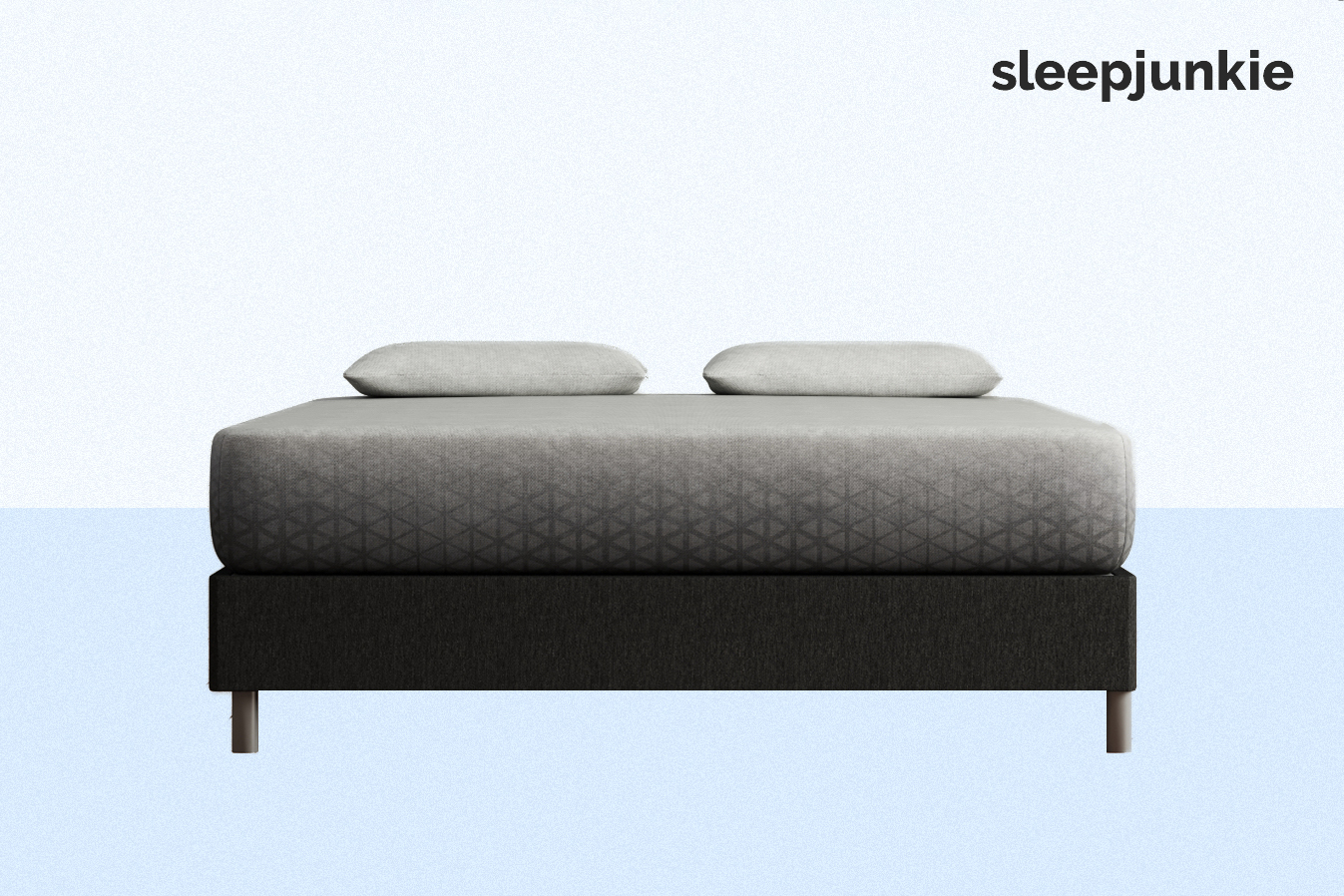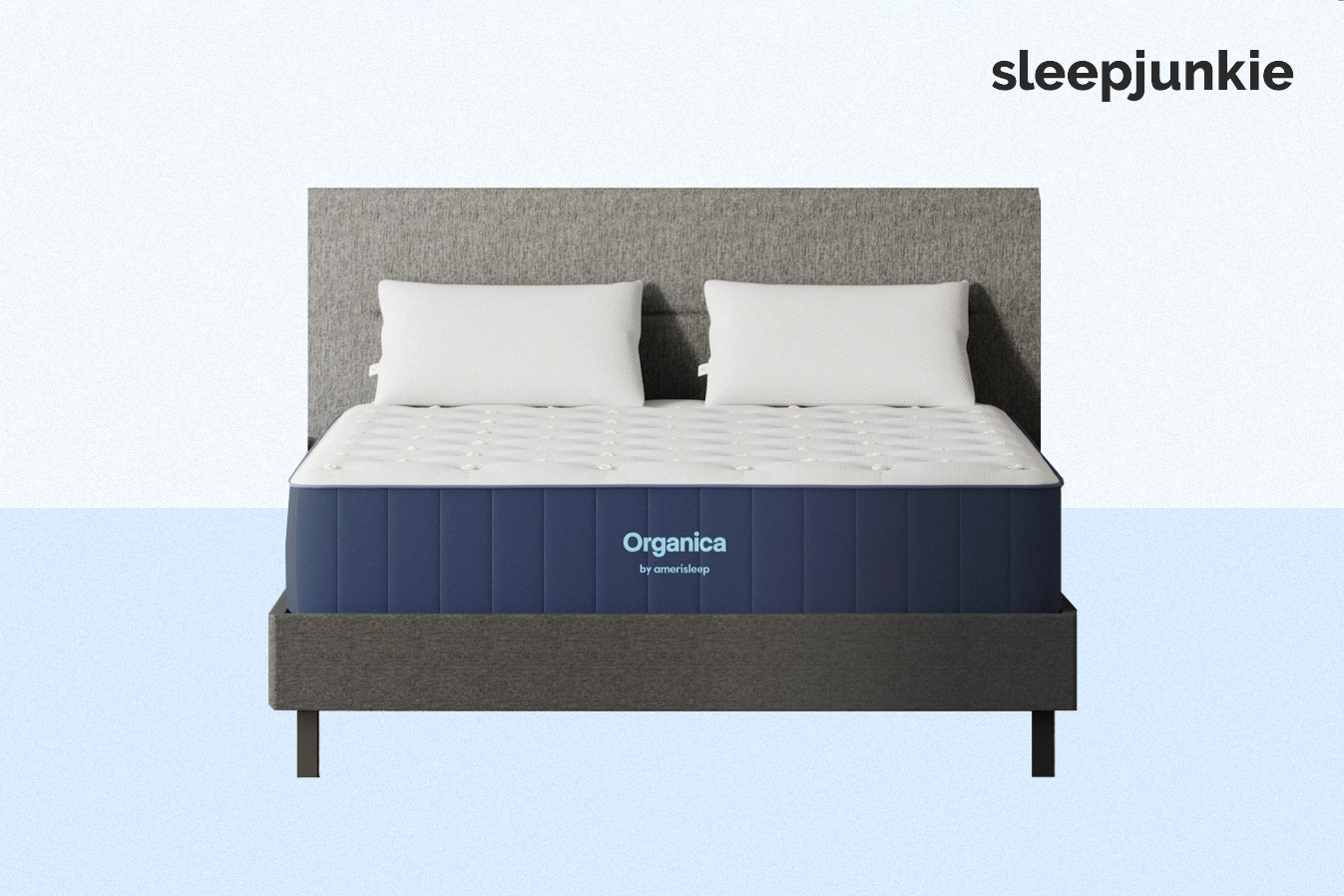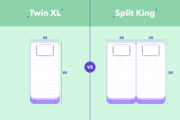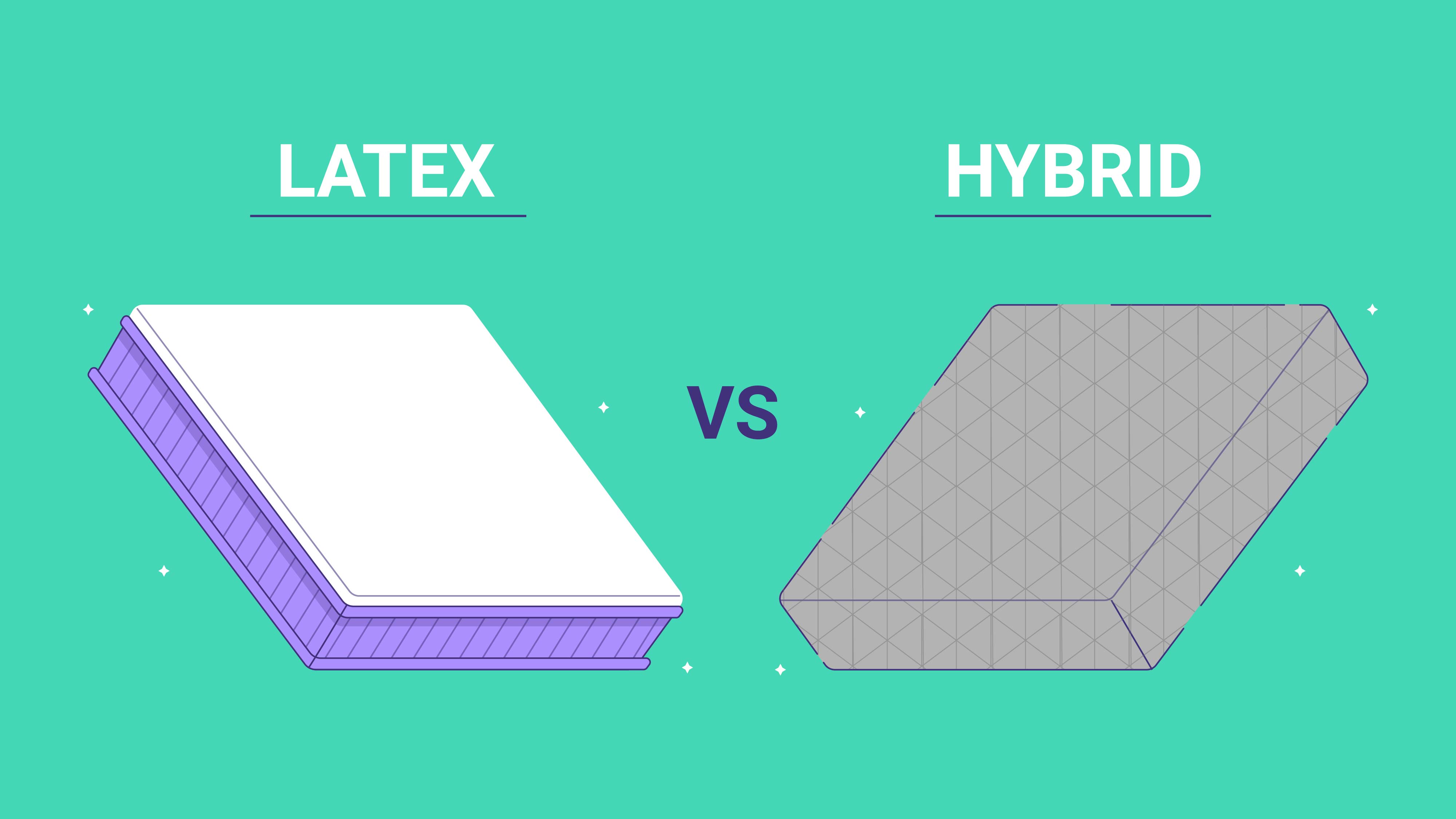
Latex vs. Hybrid: What’s the Difference?

- Latex mattresses are made from natural latex, sourced from the sap of rubber trees, and can be either Talalay or Dunlop latex. They are known for their springiness, contouring feel, and eco-friendliness, especially if certified organic.
- Hybrid mattresses, on the other hand, combine foam layers with a bottom layer of pocketed coils. They offer a balance between the bounce of innerspring mattresses and the contouring of foam, making them a good option for those accustomed to the feel of springs.
- The choice between latex and hybrid mattresses depends on individual preferences for feel, temperature control needs, budget considerations, and the importance placed on eco-friendliness and durability.
Those looking for a new mattress might think it doesn’t really matter if they get a latex or a hybrid mattress. However, latex and hybrid mattresses have different constructions and different feels. You might love one and be more apathetic towards the other. You also only really have one option if you want an eco-friendly bed.
Below, we’ll go over the main differences between hybrid and latex mattresses. We’ll also talk about how to decide which could be right for you.
Latex
Natural latex is one of the best mattress materials on the market. Latex foam is made from the sap of the rubber tree. The raw sap is whipped into a foam and then processed into one of two latex types: Talalay or Dunlop.
Natural Talalay latex is not as dense as Dunlop latex. It’s springier and more contouring. This is why it’s common to see Talalay latex in the comfort layer of your latex mattress and higher-density natural Dunlop latex in the support layer.
Certified organic latex is one of the purest and eco-friendliest materials for a mattress. The Global Organic Latex Standard (GOLS) sets strict standards about purity and environmental impact. So if you purchase a GOLS-certified organic mattress, you can rest assured it was made in an eco-friendly facility and without toxic chemicals.
Feel
Dunlop and Talalay latex have slightly different feels, but most people don’t notice a huge difference between them. Both Dunlop and Talalay latex will feel naturally springy without any chemical additives or spring bottom layers required.
Latex is also highly breathable. That means it will allow for more airflow than even an average hybrid mattress, as most hybrid mattresses are made with memory foam. In addition, a benefit of latex is that it’s naturally breathable throughout without needing any additional help.
Temperature Control
Because a natural latex mattress is so naturally breathable, it pulls your body heat away from you. That means latex mattresses are great for temperature control. They don’t need gel microbeads, copper infusions, or any other cooling technology. Instead, they’re pleasantly cool on their own. Hot sleepers who want to avoid synthetic ingredients and enjoy a mattress for allergies will appreciate this.
See our gel memory foam vs latex guide for an in-depth comparison of these cooling materials.
Responsiveness
When it comes to the differences between memory foam and latex, memory foam is more contouring than latex. Latex wants to retain its shape, while memory foam wants to alter its shape to take yours. However, there’s a tradeoff. Latex might be slightly less adaptable than the memory foam in an average hybrid, but it’s a whole lot more responsive.
Anyone who moves around at all during the night will appreciate that latex instantly springs back into place as soon as they change positions.
Durability
So, how long does a latex mattress last? Latex beats out every mattress material when it comes to durability. Hybrid mattresses are usually lucky to make it to 15 years old. Meanwhile, natural latex beds will last and last. So you can expect to get at least two decades out of your latex mattress. However, it’s not unheard of for denser Dunlop mattresses to last three or even four decades.
Cost
Latex is the most expensive mattress material initially. You can expect to pay an average of around $2,000 for a queen size latex mattress. However, with latex’s fantastic durability, its cost over time is reduced. If you pay $2,000 for a mattress that lasts 20 years, you pay just $100 per year of use. That drastically cuts the long-term cost of latex mattresses.
See Also: Latex Vs Gel Memory Foam Pillow
A Note on Synthetic Latex
There is a type of foam that’s often touted as a latex alternative. Styrene-Butadiene Rubber (SBR) is a synthetic latex spun out of petroleum products instead of natural rubber. While this foam claims to imitate the feel of latex, it doesn’t stack up.
SBR is not supportive like latex is. That means it won’t support the spine to encourage alignment. SBR also is not breathable like latex. It is not responsive like real latex. And it’s full of potentially harmful chemicals. All in all, SBR is no substitute for the real deal. It normally comes in cheap, low-quality mattresses and is best to avoid.
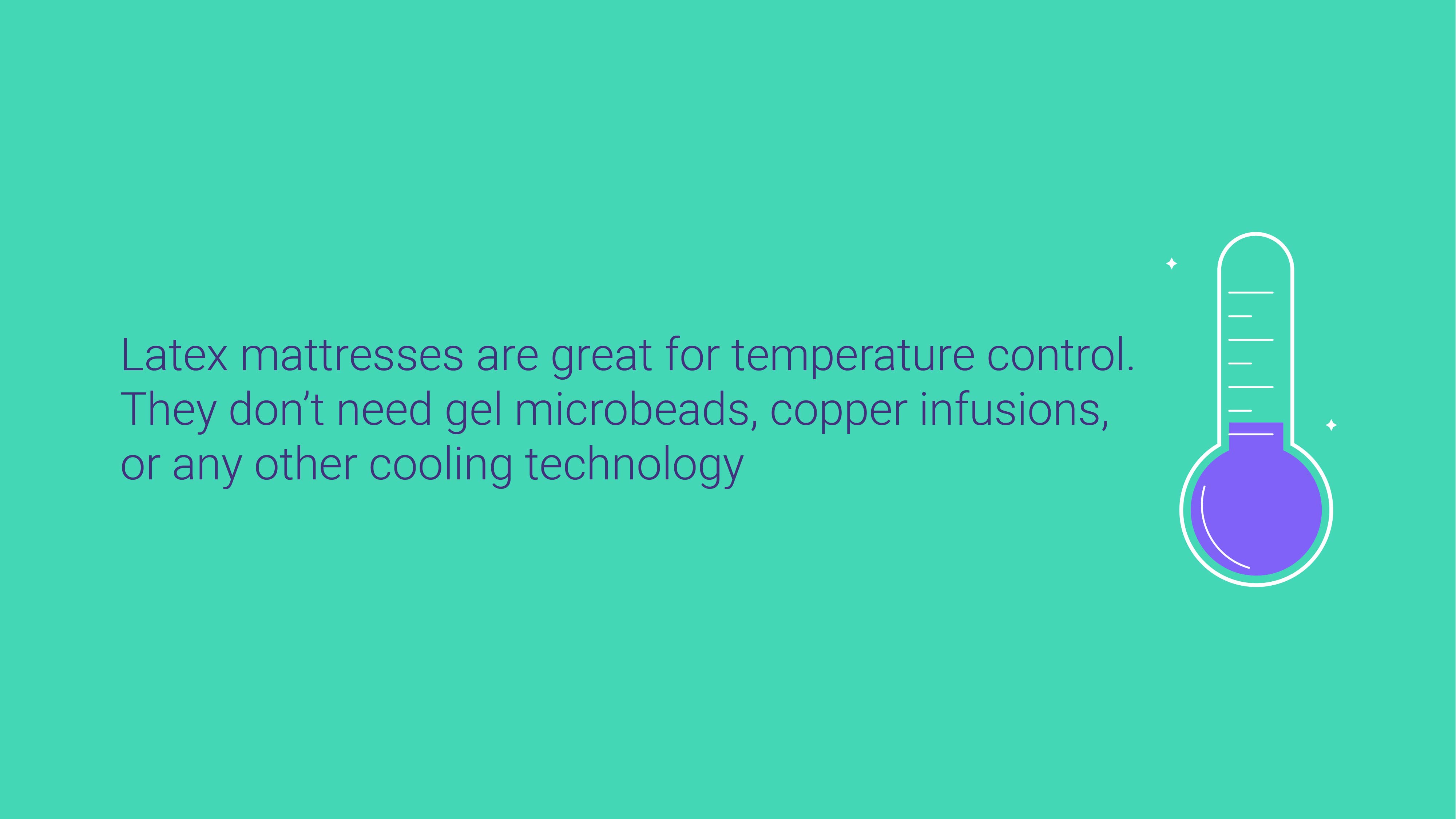
Hybrid
Hybrid mattresses are an excellent alternative to latex mattresses for those who don’t want to give up on the feel of springs. If you’ve gotten used to the bounce of an innerspring mattress, even pure latex might not be responsive enough for you.
Hybrids combine top layers of foam with a bottom layer of pocketed coils. The comfort layer of a hybrid must be at least two inches thick for it to be considered a hybrid. If it has a thinner comfort layer, it’s an innerspring mattress. Hybrids also cannot have open coils. If it has any other spring system than an individually wrapped coil support core, it’s also an innerspring mattress.
Pocketed coils help improve the support and durability of a hybrid mattress. They’re more adaptable than open coils to encourage spinal alignment. And they’re more durable than open coils, able to resist sagging for up to a decade longer. See our open coils vs pocket springs guide for more information.
The pocketed spring base makes hybrids a huge improvement over innerspring mattresses.
Feel
Hybrids significantly increase adaptability over innerspring mattresses without sacrificing their bounce. Hybrids are definitely bouncier than latex mattresses because of their coil support cores. They may also be more contouring if they’re made of memory foam. Contouring memory foam combined with independently moving coils makes for a highly adaptable mattress.
Temperature Control
The coils in a hybrid’s support core allow for tons of airflow to establish a cooling mattress for hot sleepers. In terms of breathability, a hybrid whips a memory foam mattress. However, it may not be cooler than latex, depending on the materials it contains.
Hybrids made with traditional memory foam may not be as breathable or cooling as latex mattresses. But hybrids made with latex foam or gel memory foam may be even more cooling than a pure latex mattress. Hybrids have such a huge range of possible materials, and that creates a wide range of possible sleeping temperatures.
Responsiveness
Since hybrids have springs in their support cores, they’re usually pretty responsive. Pocketed coils are not as bouncy as open coils. But they’re much better than open coils at controlling motion transfer.
Hybrids offer innerspring lovers more bounce than latex mattresses, and they also provide a good balance between contouring and support. Hybrids are also some of our top recommendations when it comes to mattresses for combination sleepers.
Durability
Hybrids have coils. Coils lose tension over time. That can seriously cut the life expectancy of a hybrid mattress. While pocket coils are more durable than open coils, they’re not as durable as solid latex foam. That means you can expect your hybrid mattress to last 10 to 15 years. It’s not very common to see a hybrid make it to 20.
Cost
Hybrid mattresses have a slightly lower initial cost than latex mattresses. At an average of $1,700 for a queen, hybrids are still comparatively expensive but still a few hundred dollars cheaper than latex.
However, when you factor in hybrids’ decreased durability, their long-term cost easily outstrips that of latex. If you have a $1,700 hybrid that only lasts 12 years, you’re paying over $140 per year of using the mattress. That makes hybrids the most expensive type of mattress over time.
Our favorite hybrid mattress is the Zoma Hybrid, a cooling bed built for athletes. It’s built to facilitate quality sleep while soothing achy muscles and joints. The 12-inch mattress has a medium to medium-soft feel which is great for side and combo sleepers, joint pain sufferers, and hot sleepers.
Under the moisture-wicking AirCloth cover is a gel foam comfort layer. Infusing gel into foam prevents heat retention, keeping you cool and dry throughout the night. The foam itself cushions achy muscles, hips, and shoulders to help you sleep pain-free.
Next is a layer of Reactiv™ transition foam. As the name suggests, this foam reacts to your movements for optimal support and alignment. It makes switching positions and getting out of bed less of pain, especially late at night.
As a hybrid bed, the Zoma Hybrid’s support system is made from pocketed coils. Pocketing the springs helps with durability, motion isolation, and support. The reinforced coils on the sides of the bed increase the bed’s edge support and prevent sagginess.
At the base of the bed is a durable base that supports the coils and absorbs shocks. Not only that but the foam ensures your bed lasts for years to come.
The Zoma Hybrid includes free shipping, free returns, a 100-night trial, and a 10-year limited warranty.
ZOMA HYBRID
- Made for athletes, great for anyone
- Improves sleep quality and muscle recovery
- Breathable and moisture-wicking
Latex Hybrid
If you want the best of both worlds, you can always spring for a latex hybrid. These are among the coolest, most comfortable mattresses. They may have one to three layers of latex foam with different densities on top and pocketed coils on the bottom. They might also have a durable base foam layer to help increase motion isolation.
Latex hybrids are as breathable, springy, and cooling as it gets. They’re also comparatively pure. The only component of your latex hybrid mattress that isn’t all-natural will be its coils.
Our favorite latex mattress is the Amerisleep Organica. Not only does it contain two types of latex, but they’re Standard 100 by OEKO-TEX®, eco-INSTITUT, and Rainforest Alliance certified. This 13-inch bed has a medium firmness, which suits a wide range of sleepers.
Inside the Organica is 1 inch of New Zealand Joma Wool®, a 3-inch Talalay latex comfort layer, an 8-inch pocketed coil unit, and a 1-inch Dunlop latex base. The mattress’s cover is made from GOTS organic certified cotton.
The New Zealand Joma Wool® is a flame barrier and thermo-regulator. This means the Organica is free of chemical or fiberglass flame barriers, keeping you safe from potential irritants.
Talalay latex is soft and cushiony, which is why it makes for a great comfort layer. Unlike memory foam, Talalay latex has lots of bounce, keeping your body lifted and preventing you from feeling unable to move in bed.
Amerisleep wraps the coils in their beds with light fabric to minimize wear, squeaking, and motion transfer. This way, the mattress lasts longer and you are better supported when sleeping. Also, the coils on the sides of the bed are extra-firm, which prevents sagging. The Dunlop latex at the base of the bed protects the coils and helps your mattress lasts as long as possible.
With the Organica, you receive free shipping and returns, a 100-night trial, and a 20-year warranty.
AMERISLEEP ORGANICA
- Suitable for all types of sleepers
- Contains two types of natural latex
- Rainforest Alliance, eco-INSTITUT, and Standard 100 by OEKO-TEX® certified
Other Mattress Types
Aside from latex and hybrid mattresses, you have two other basic types of mattresses.
Memory Foam
Memory foam is a special type of polyurethane foam made to cradle pressure points and adapt to your body no matter your sleeping position. Memory foam is the most contouring of all the mattress materials. That makes a memory foam mattress the best for pressure relief.
However, the tradeoff is that memory foam’s response time is slower, as a mattress without springs. And its temperature control ability is not great unless it has cooling infusions or perforations. Also, if you’re looking for a foam bed made of natural materials and using eco-friendly manufacturing processes, a memory foam bed is not for you.
Innerspring
Innerspring mattresses rely on a network of unwrapped coils wired together. The comfort layer on top of these coils is usually thinner and made of various plush materials like fiberfill, cotton, wool, etc.
Innerspring mattresses are an older sleep technology. So they’ve been mostly superseded by newer inventions. Even high-quality pillow top or Euro top innerspring mattresses just can’t compete with hybrids in terms of support and cushioning.
Their only real advantages are their price and mobility. Innerspring mattresses are lighter and easier to move than other mattress types. They’re also cheaper, though their lower durability offsets their affordability in the long term.
FAQs
Which is the most eco-friendly mattress, hybrid or latex?
Latex takes the cake here. Not only does the latex manufacturing process produce less greenhouse gas and toxic waste. Organic natural latex is also biodegradable. Your memory foam hybrid might stick around for a few thousand years if you don’t recycle it. But your natural latex mattress will break down over time. Latex can also be easily recycled as well.
Do hybrid and latex mattresses off-gas?
Off-gassing is when your mattress has that chemically “new mattress” smell. This is actually caused by Volatile Organic Compounds (VOCs) that get trapped inside the mattress during the manufacturing process. When you pull your mattress out of the packaging and the foam starts to expand, it releases VOCs into the air.
Latex mattresses don’t off-gas, but hybrids might. All mattresses containing memory foam will off-gas some. Memory foam hybrids with a CertiPUR-US certification also won’t do a whole lot of off-gassing. So keep in mind that even if your mattress smells strongly, it’s unlikely it contains enough VOCs to actually put your health at risk.
Is a hybrid or latex mattress firmer?
The firmness level is not decided by mattress type but by the thickness and plushness of a mattress’s comfort layer. That means any material can come in many different firmness levels. So anyone can have whatever material they like regardless of their firmness needs.
You should choose your firmness level based mostly on your sleeping position. Side sleepers need the softest mattresses. Stomach sleepers need the firmest. Back sleepers and combination sleepers fall somewhere in the middle.
Is a hybrid or latex mattress more durable?
Latex mattresses are much more durable than hybrids. Hybrids have coils that break down over time. This will eventually lead to sagging and soft spot development. Memory foam, as a synthetic material, is also not as durable as natural latex.
So memory foam hybrids will break down faster than latex hybrids. Natural latex mattresses have no coils to break down, so they will outlast any other mattress type. If you want to know the durability of any mattress, check out the warranty.
Warranties are a good indicator of how durable makers think their product is. For instance, a 20-year warranty means the manufacturer is so sure their product will last 20 years that they’re willing to put money on it.
Which is the best mattress for those with allergies, hybrid or latex?
Either latex or a hybrid could work. Latex and memory foam both fight mold and mildew buildup. They also both fight dust mites, another common allergen. That means any hybrid material could be hypoallergenic.
Allergy sufferers should also think about their mattress’s cover. Covers made of Global Organic Textile Standard (GOTS) certified organic wool or organic cotton can also fight allergies. An organic cotton cover also has the added advantage of being highly breathable to wick away heat and moisture.
Bottom Line
Both latex and hybrid mattresses are fantastic options for those who like springy and breathable mattresses. If you want more adaptability and bounce, go for a hybrid. If you desire more purity and durability, spring for an all-latex mattress. And don’t forget, with a latex hybrid, you can have both!
